If you were expecting some kind of sun sign nonsense, forget it. This is real astrology. See the section above. Please note: this forecast is expressed in terms of Universal Time (UT).
The future is only the past again,
entered through another gate.
--Arthur Wing Pinero
War and economic collapse were the hallmarks of 2001, the year that showed how "what does not kill me makes me stronger." We who have carried on into 2002 take those themes forward into the future, as we navigate a year of economic rebuilding and continued conflict between Western civilization and Islamic fundamentalism. In neither case should victory be taken for granted: battles won today will flare up again at a later time, as surely as one Crusade begets another.
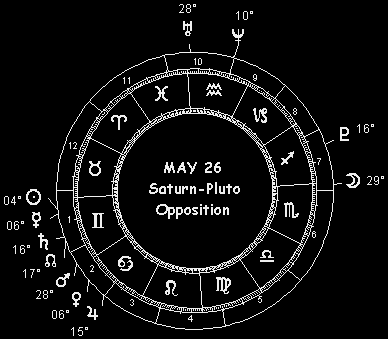 Vital trends begun in 2001 spill over into 2002, projecting some elements of similarity and continuity into the new year. The world economy is a prime example. Last year saw Saturn line up in opposition to Pluto twice, in the first two instances of a triple alignment that finally ends in 2002 with the third and final pass on May 26. (This is in the geocentric - i.e. Earth-centered - perspective, by the way. From a heliocentric - Sun-centered - point of view, the alignment of these two planets occurs this year, on March 30.)
Vital trends begun in 2001 spill over into 2002, projecting some elements of similarity and continuity into the new year. The world economy is a prime example. Last year saw Saturn line up in opposition to Pluto twice, in the first two instances of a triple alignment that finally ends in 2002 with the third and final pass on May 26. (This is in the geocentric - i.e. Earth-centered - perspective, by the way. From a heliocentric - Sun-centered - point of view, the alignment of these two planets occurs this year, on March 30.)
Saturn aligns in opposition to Pluto on a 35-year cycle, as seen from Earth. Typically, this alignment will occur three times in the course of a year - and then another 35 years must pass before the alignment takes place again. The last geocentric Saturn-Pluto opposition was the 1965-66 triple play (the Vietnam War took off); and before that it was the 1931 triplet (the Great Depression, Japanese invasion of Manchuria). The last time this opposition occurred with Saturn in Gemini and Pluto in Sagittarius - as is now the case - was the 1266-1267 'three-peat' (Marco Polo in China, the Crusades in progress).
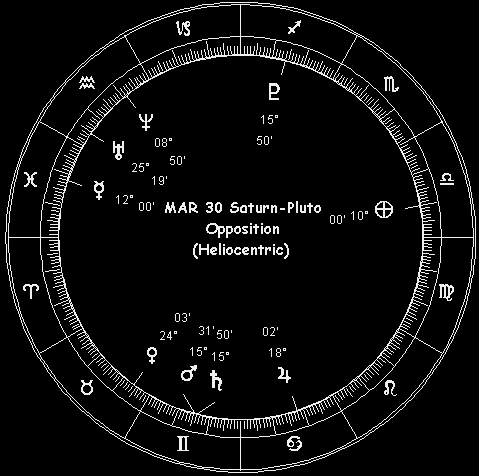 It's clear by now that a US economic slowdown began in 2001, the year the current geocentric Saturn-Pluto opposition began. It's also clear that the US downturn was followed by weakness and even crisis in other national economies as the year wore on (e.g. Argentina). As the Saturn-Pluto opposition runs its course with the two alignments of 2002 (March and May), it appears that the worst of the economic downturn will be over by about mid-year - provided there's no horrific escalation in the current world war.
It's clear by now that a US economic slowdown began in 2001, the year the current geocentric Saturn-Pluto opposition began. It's also clear that the US downturn was followed by weakness and even crisis in other national economies as the year wore on (e.g. Argentina). As the Saturn-Pluto opposition runs its course with the two alignments of 2002 (March and May), it appears that the worst of the economic downturn will be over by about mid-year - provided there's no horrific escalation in the current world war.
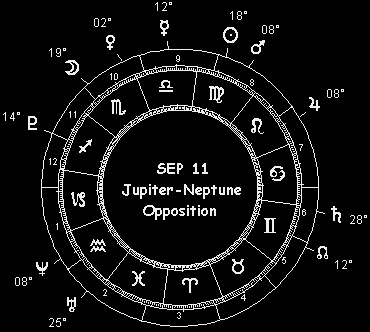 About the only thing that could rock the boat going forward may be hinted at by the Jupiter-Neptune opposition coming up on September 11 (geocentric) and at year's end (heliocentric). This is one of the new trends for the year, one of the Jokers in the deck. Broken political promises, fake reforms, Ponzi schemes and "irrational exuberance" in the markets are par for the course under such an alignment - and the rug can be pulled out so very fast at times like this. This being an alignment which from a geocentric perspective continues into 2003, it's far from over this year. (The last time this alignment fell in the Leo-Aquarius polarity - Jupiter to Neptune - was in 1836.) This seems to mark the end of a deflationary cycle, perhaps because people are coming to lose faith in promissory notes of one kind or another - resulting in currencies losing value relative to commodities.
About the only thing that could rock the boat going forward may be hinted at by the Jupiter-Neptune opposition coming up on September 11 (geocentric) and at year's end (heliocentric). This is one of the new trends for the year, one of the Jokers in the deck. Broken political promises, fake reforms, Ponzi schemes and "irrational exuberance" in the markets are par for the course under such an alignment - and the rug can be pulled out so very fast at times like this. This being an alignment which from a geocentric perspective continues into 2003, it's far from over this year. (The last time this alignment fell in the Leo-Aquarius polarity - Jupiter to Neptune - was in 1836.) This seems to mark the end of a deflationary cycle, perhaps because people are coming to lose faith in promissory notes of one kind or another - resulting in currencies losing value relative to commodities.
Any Saturn-Pluto opposition speaks of the potential for disruptive financial adjustment. It's a time of paybacks, when what is over-valued or taken for granted gets deflated if not destroyed. America in particular has been a focus of this trend last year (and continuing into the middle of 2002), because the Saturn-Pluto alignment is in the Gemini-Sagittarius axis. These two signs are prominent in the US Declaration of Independence chart, which features Mars (and Uranus) in Gemini and Sagittarius rising. Ironically, Sagittarius has long been considered symbolic of the Arab world as well, so there's reason to expect that America's conflict with Islamic fundamentalism will remain intense in early 2002. There's likely to be a peak in the March-June time frame, followed by an easing of tension - but a continued state of vigilance for some time afterwards.
Islamic terrorists, in attacking the US, contributed to the nation's economic decline; but the economy was already cooling off before the attacks happened. Partly this reflected an evaporating wealth effect as the stock market bubble burst. And then the financial markets themselves plunged in reaction to the fear and uncertainty spawned by terror attacks and the US military response. We're still going to see these kinds of attacks and market panics in 2002, particularly from March into June. At least, that's the clear message of the Saturn-Pluto opposition and several potent Mars alignments.
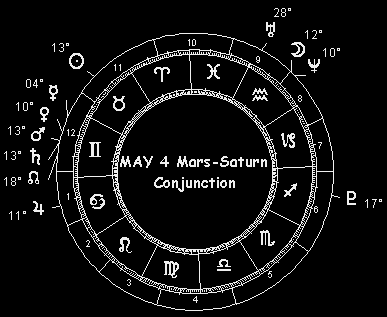 Mars aligns with Saturn again this year. The conjunction is exact on May 4, and within just a few degrees from the end of April through May 10. Criminal violence and brutality are par for the course at times like this, from the family level right on up to the sphere of international conflict. It's a good time to be security conscious, to watch your back, to trust the instinct that says "something's wrong here, beware." From lone gunman mass murder types to terrorists to one nation's military launching an attack on another, this is one of those times when headlines are full of human brutality.
Mars aligns with Saturn again this year. The conjunction is exact on May 4, and within just a few degrees from the end of April through May 10. Criminal violence and brutality are par for the course at times like this, from the family level right on up to the sphere of international conflict. It's a good time to be security conscious, to watch your back, to trust the instinct that says "something's wrong here, beware." From lone gunman mass murder types to terrorists to one nation's military launching an attack on another, this is one of those times when headlines are full of human brutality.
Frankly, compared to last year's Mars-Saturn opposition, there's every reason to hope that 2002 will fall short of 2001's bloody toll. That's because the conjunction of these two planets points to a more personal and individual than collective level of violence; more of the face-to-face and surgical type of conflict than the mass variety, in other words. (It's also because, unlike last year, Mars makes no close approach to Earth in 2002.) If we can get past the April to August period - when other factors combine to raise the risk of terror attacks - it's conceivable that 2002 could be relatively free of the kind of horrors that characterized 2001.
Another potential associated with this kind of Mars-Saturn alignment - particularly as it's in Gemini - is danger connected with travel and shipping. Mostly this is by accident (including weather-related mishaps and human error), but it's impossible to rule out sabotage and other criminal causes.
Mars' conjunction with Saturn is only one of quite a few strong Red Planet aspects that bear watching in 2002. These include the Mars opposition to Pluto in early May (exact on the 8th), to Neptune in late July, and to Uranus in late August. These are essentially more of the same in terms of what to be alert for as the alignments take place: a heightened potential for violence and conflict. Other dates when tensions are likely to rise and tempers boil over come around May 17 (Mars opposes the December 14, 2001 eclipse degree) and 29 (Mars at the June 21, 2001 eclipse degree); plus June 11 (Mars at the December 30, 2001 eclipse degree) and 18 (Mars opposes the July 5, 2001 eclipse degree). Eclipse degrees tend to remain sensitive to subsequent Mars alignments of this sort, as illustrated by the September 11 terror attacks on Manhattan and the Pentagon: these occurred while Mars was within just a degree of exact opposition to the previous solar eclipse (June 21, 2001). Be alert, stay focused, be ready, stay safe.
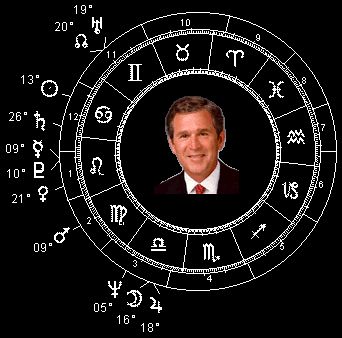 The eclipses of 2001 focused on the Cancer-Capricorn polarity, right up until the last eclipse of the year - which began the shift into the Gemini-Sagittarius polarity. Ironically, President Bush became the man of the hour as a result of the terrorist sneak attack on the US. Bush was born with the Sun in Cancer of course, so astrologically it's no surprise that he's been astride the world stage ever since - what with the eclipses in his sign and Jupiter transiting there as well.
The eclipses of 2001 focused on the Cancer-Capricorn polarity, right up until the last eclipse of the year - which began the shift into the Gemini-Sagittarius polarity. Ironically, President Bush became the man of the hour as a result of the terrorist sneak attack on the US. Bush was born with the Sun in Cancer of course, so astrologically it's no surprise that he's been astride the world stage ever since - what with the eclipses in his sign and Jupiter transiting there as well.
The changeover from Cancer-Capricorn eclipses is complete in 2002, the last of them occurring on June 24 (the lunar eclipse at 3 Capricorn). This comes near the end of the Jupiter transit through Cancer as well. Among other things, I take these indicators as further signs that economic recovery is clearly underway in the US by the second half of the year.
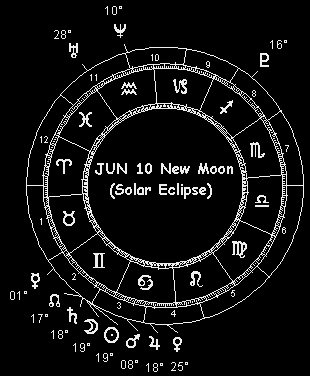 Gemini-Sagittarius eclipses, giving way into the Taurus-Scorpio polarity, are where it's at for the rest of 2002 and on into next year. These indicators suggest some kind of jolt in President Bush's public approval ratings in the June-July period, most especially around the time of the June 10 solar eclipse: a friend or friendly coalition could be lost. This same eclipse polarity suggests American involvement in military conflict - even the possibility of a terrorist attack on Americans whether at home or abroad. Late May and early to mid-June are windows of extreme vulnerability in this regard. While incidents of this sort may at first cost the President a certain measure of public confidence, he soon benefits from a "rally 'round the flag" sentiment.
Gemini-Sagittarius eclipses, giving way into the Taurus-Scorpio polarity, are where it's at for the rest of 2002 and on into next year. These indicators suggest some kind of jolt in President Bush's public approval ratings in the June-July period, most especially around the time of the June 10 solar eclipse: a friend or friendly coalition could be lost. This same eclipse polarity suggests American involvement in military conflict - even the possibility of a terrorist attack on Americans whether at home or abroad. Late May and early to mid-June are windows of extreme vulnerability in this regard. While incidents of this sort may at first cost the President a certain measure of public confidence, he soon benefits from a "rally 'round the flag" sentiment.
At about the same time, a changeover in Jupiter's sign transit is going on as well, as the giant planet slips into Leo for a year-long sojourn starting in August - the only major planetary sign change of 2002. This very strongly suggests a return to good times for the travel and entertainment industries by and large; it's also good for well-managed gold mining stocks and companies that target the youth market. President Bush should do well holding onto public approval for the duration of the Jupiter transit through Leo.
The eclipses of 2002 deserve further consideration in their own right, along with the year's SuperMoons. (SuperMoon is a term I introduced in a series of articles for Dell's HOROSCOPE magazine back in 1979. It means a new or full moon which occurs when the Moon is at or near its closest approach to Earth. I have since refined 'at or near' to mean Luna within 90% or higher of its closest approach to Earth.) Eclipses and SuperMoons are important geocosmic indicators at many levels, not least of which is the way they tend to coincide with strong storms, flooding and moderate to severe seismic activity (including volcanic eruptions and Richter 5 or greater earthquakes). Note: all SuperMoons and eclipses, being planetary in scale, have potential impact all 'round the world. And this year's batch is stronger than last year's, all else being equal, because the Moon's maximum declinations are getting more and more extreme as the year wears on. Detailed below are some particular locations that appear to be especially vulnerable at the time of each individual eclipse and SuperMoon.
First off in this year's major solunar lineups is the February 27 SuperMoon, a full moon at 9 Virgo. In effect from the 24th through March 2, this particular alignment ushers in a heightened worldwide potential for storms and seismic activity as usual. However in particular, east Africa and the Middle East appear to be in the astro-locality crosshairs, along with Japan, Indonesia, eastern China and northeastern India, eastern Brazil, western Alaska and the Gulf of Alaska, and the US Mississippi Valley area.
The March 28 full moon at 8 Libra is the next SuperMoon, upping the ante for increased flooding as well as storm and seismic activity March 25-31. Its planet-wide potential aside, this one looks especially risky for the Missouri River valley in the US, the Brazil-Uruguay border area, Great Britain, along a line running diagonally from the tip of South Africa through the Middle East; and on a line through west Australia up through the Korean peninsula.
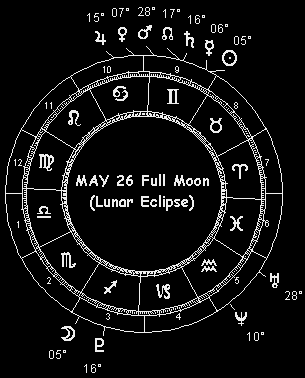 The first of the 2002 eclipses is the Full Moon (lunar eclipse) at 5 Sagittarius on May 26 (in effect May 23-29). This one is a major storm and seismic indicator worldwide, perhaps the strongest of the year to date. Apart from its planet-wide scope, this particular eclipse appears especially strong across the Bering Strait and down through the Rockies all the way into Argentina, and then up through Indonesia and across to the Philippines on into Japan; also along a north-south line that runs through west central Africa, across the eastern Mediterranean area and through Turkey.
The first of the 2002 eclipses is the Full Moon (lunar eclipse) at 5 Sagittarius on May 26 (in effect May 23-29). This one is a major storm and seismic indicator worldwide, perhaps the strongest of the year to date. Apart from its planet-wide scope, this particular eclipse appears especially strong across the Bering Strait and down through the Rockies all the way into Argentina, and then up through Indonesia and across to the Philippines on into Japan; also along a north-south line that runs through west central Africa, across the eastern Mediterranean area and through Turkey.
The June 10 solar eclipse at 20 Gemini signals an increase in storm and seismic risk worldwide from the 3rd through the 17th. This particular alignment could end up being especially costly in terms of damage to property, if not in terms of human life per se. Visible in most of North America, as well as from northern Australia through the island nations of the South Pacific and throughout much of Asia (including much of Indochina, China and all of Japan) . . . these are bound to be some of the notable target areas this time around. Other risk zones, as suggested by astro-locality, include western Alaska plus the Aleutians and Hawaii; also a couple of north-south strips running from west Africa up through western Europe and from central Africa up through the Mediterranean and across eastern Europe; plus an arc through Central America and the Caribbean Sea in the west and down the India-China border into eastern India in the east. Coming just four days after Saturn aligns with the Moon's north node, this solar eclipse signals great danger for the US. It falls right on Mars in the US Declaration of Independence chart, for one thing: a warning of war and destruction. A warning intensified by Saturn being conjunct both the eclipse and the north lunar node while at the same time opposing Pluto. This eclipse, incidentally, belongs to Saros Cycle 137. That cycle began in 1389, a seminal period in the early development of nationalism in Western civilization.
Rounding out this initial eclipse trio is the full moon lunar eclipse at 3 Capricorn on June 24 (in effect from the 21st through the 27th). As always, the flooding, storm and seismic potential associated with this alignment can manifest virtually anywhere on Earth. That said, there may be a few astro-locality clues as to areas of special risk this time around. They include the Pacific Northwest coast, Hawaii and western Alaska, east Africa and the Middle East, Great Britain and northern Europe on across Russia and down through eastern China, Japan; as well as the South Pacific down through the northeast coast of Australia on across New Zealand.
The September 7 new moon at 14 Virgo (in effect from the 4th through the 10th) is the first of several SuperMoon alignments that juice up the worldwide potential for storms and seismic action in late summer and early fall of 2002. Its planetary scope notwithstanding, astro-locality points to special vulnerabilities in the Pacific Northwest, eastern Brazil, eastern Europe down through the Mediterranean Sea into east Africa; and along a northerly line from western Australia up through the Korean Peninsula on into eastern China.
October 6 brings another new moon SuperMoon, this one in effect the world over from the 3rd through the 9th. Still, astro-locality maps out some potential flood, storm and seismic hot spots in particular, along coastal west Africa, eastern India and western China plus the Indochina peninsula; the Bering Straits; the Plains States down into eastern Mexico; Great Britain; and New Zealand.
The year's last SuperMoon, another new moon, takes place at 12 Scorpio on November 4. From the 1st through the 7th, it ups the ante for an outbreak of storm and seismic action worldwide. Among particular areas at risk, astro-locality points out Alaska and Hawaii and the eastern Pacific region (includng the Pacific Northwest coast); also the east coast of Brazil and northward into the mouth of the Caribbean; along a northerly strip up central Africa into eastern Europe.
The Taurus-Scorpio eclipse series springs to life with the lunar eclipse at 28 Taurus on November 20. This full moon eclipse raises the planet-wide potential for flooding, storms and seismic activity from the 17th through the 23rd. Hawaii, Alaska and east Africa up into the Middle East show astro-locality vulnerabilities this time around; north-south zones bracketing Australia on the east and west carry the solunar risk factors northward through the Pacific up to east Asia; along with a similar north-south strip bisecting South America and running up to eastern Canada.
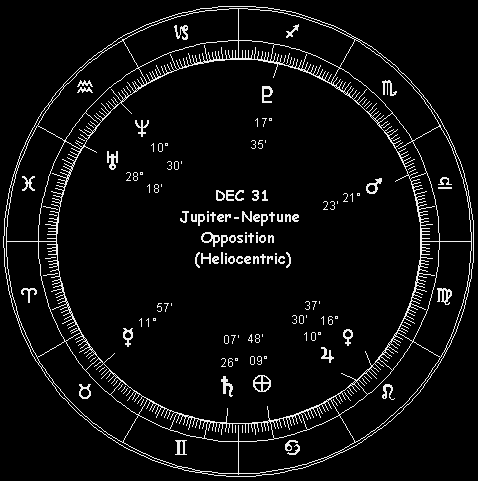 Last but most definitely not least is the December 4 solar eclipse at 12 Sagittarius, upping storm and seismic risk (and flood potential) worldwide from November 27 through December 11. Global potentials aside, there are some astro-locality indications that Hawaii and Alaska are in the crosshairs this time around; along with a north-south zone running from the tip of South Africa up through eastern Europe; also the Plains States, the India-Pakistan-Afghanistan-Iran region, and eastern Australia. Given that the Africa-to-Australia region includes the zone of visibility for this eclipse, you can figure these will be prime target areas. This eclipse, incidentally, falls right on the ascendant in the US Declaration of Independence chart and belongs to the Saros Cycle 142 sequence, which began in 1624 - a time when European nationalism and colonialism were laying the foundations for much of today's geopolitics; also a time when a new dynasty was established in Russia, with the advent of the first of the Romanovs. The connection nationalism and colonialism have with the current conflict between the West and the rest of the world is self-evident. The so-called "war on terrorism" is in reality just another Crusade. It won't be over in our lifetime, even if it does fade away for a while.
Last but most definitely not least is the December 4 solar eclipse at 12 Sagittarius, upping storm and seismic risk (and flood potential) worldwide from November 27 through December 11. Global potentials aside, there are some astro-locality indications that Hawaii and Alaska are in the crosshairs this time around; along with a north-south zone running from the tip of South Africa up through eastern Europe; also the Plains States, the India-Pakistan-Afghanistan-Iran region, and eastern Australia. Given that the Africa-to-Australia region includes the zone of visibility for this eclipse, you can figure these will be prime target areas. This eclipse, incidentally, falls right on the ascendant in the US Declaration of Independence chart and belongs to the Saros Cycle 142 sequence, which began in 1624 - a time when European nationalism and colonialism were laying the foundations for much of today's geopolitics; also a time when a new dynasty was established in Russia, with the advent of the first of the Romanovs. The connection nationalism and colonialism have with the current conflict between the West and the rest of the world is self-evident. The so-called "war on terrorism" is in reality just another Crusade. It won't be over in our lifetime, even if it does fade away for a while.
The year ends with the heliocentric Jupiter-Neptune opposition on the 31st, a harbinger of what's to come politically and economically in 2003: inflation, most likely. Remember the "dot com bubble" in the markets a few years ago? Jupiter's opposition to Neptune suggests a kind of political equivalent, a governmental scheme that sounds too good to be true precisely because it is.
In closing, let's not forget the Mercury and Venus retrogrades of 2002. Mercury retrogrades are good for fixing up mistakes, because so many of them crop up at such times. Be on the lookout for Murphy's Law during the three Mercury retrogrades of 2002: January 18 to February 8, May 15 to June 8, and September 14 to October 6. Venus' much rarer retrograde takes place from October 10 through November 21. This year it happens in Scorpio, not a good sign for retail sales during that particular six week period. (If you're a marketer, you've got your work cut out for you during this cycle.)
ACKNOWLEDGMENTS: All astrological charts and astro-locality maps were calculated and produced using Matrix Software's WinStar. Eclipse maps were calculated and produced using Matrix Software's Blue*Star.
